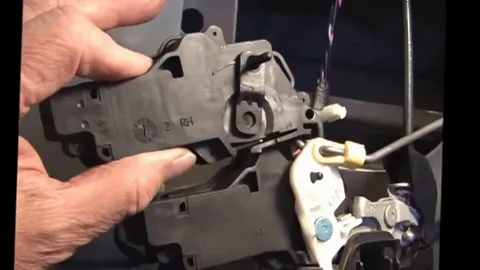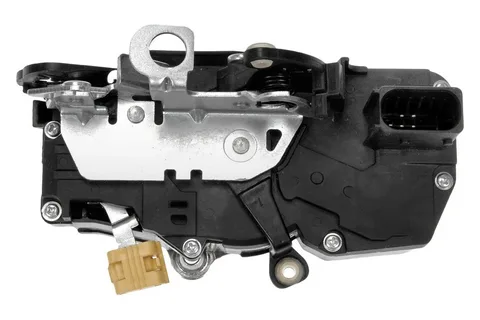Have you ever wondered how your car’s door locks keep your vehicle secure? Behind the scenes, it’s a complex combination of hardware and software that works together to protect you and your car. In this blog post, we’ll explore the inner workings of door lock actuator responsible for locking and unlocking your car’s doors. From the different types of actuators to how they interface with the rest of the system, we’ll answer all your questions about this important safety feature.
What are lock actuators?
Lock actuators are a crucial component of your car’s locking system, responsible for locking and unlocking the doors. They are small electric motors that convert electrical signals into mechanical motion. When you press the lock or unlock button on your key fob or inside your car, these actuators engage and disengage the door locks accordingly.
These actuators are typically installed inside each door and connected to the locking mechanism via rods and linkages. They are designed to move a lever or rod that physically locks or unlocks the door. This process is usually accompanied by a distinct clicking sound, indicating that the locking mechanism has been engaged or disengaged.
The central locking system typically controls lock actuators, either integrated into your car’s keyless entry system or operated manually using a key. In modern vehicles, the actuators are often powered by the car’s electrical system and are controlled by a computer, allowing for more precise and efficient operation.
Overall, lock actuators are vital in keeping your car secure. Without them, your car’s doors would not be able to lock or unlock, leaving your vehicle vulnerable to theft or unauthorized access.
Types of lock actuators
When it comes to lock actuators, there are several different types available on the market. Each type has unique design and features that make it suitable for different vehicles and locking systems.
One common type of lock actuator is the solenoid actuator. This type uses an electromagnetic coil to create a magnetic field that moves a plunger or lever, which operates the locking mechanism. Solenoid actuators are widely used in many modern vehicles due to their simplicity and reliability.
Another type is the motor-driven actuator. As the name suggests, this type uses a small electric motor to drive the locking mechanism. Motor-driven actuators offer more precise control and are often found in higher-end vehicles with advanced keyless entry systems.
Some vehicles also utilize cable-driven actuators, which use cables and pulleys to transmit motion from the actuator to the locking mechanism. These actuators are commonly found in older or larger vehicles where longer cable runs are required.
Finally, there are pneumatic actuators, which use compressed air to operate the locking mechanism. These actuators are typically used in commercial vehicles or heavy-duty applications.
It’s important to note that the type of lock actuator your car has will depend on the make and model of your vehicle. Additionally, some vehicles may have a combination of different types of actuators depending on the specific door or locking system.
Understanding the different types of lock actuators can help you make informed decisions regarding repairs or replacements.
How do lock actuators work?
Lock actuators convert electrical signals into mechanical motion to lock or unlock a car’s doors. When you press the lock or unlock button on your key fob or inside your car, the electrical signal is sent to the lock actuator, initiating its operation.
Inside the actuator are small electric motors or electromagnetic coils that generate the necessary force to move the locking mechanism. These motors or coils are powered by the car’s electrical system directly or through a control module.
Once the electrical signal is received, the actuator engages or disengages the locking mechanism. This is achieved by moving a lever or rod that locks or unlocks the door. The motion is often accompanied by a distinct clicking sound, indicating that the door lock has been activated.
In modern vehicles, a computer often controls lock actuators, allowing for more precise and efficient locking and unlocking. The computer receives signals from the key fob or internal controls and sends the appropriate signals to the actuators, ensuring synchronized operation of all doors.
Overall, lock actuators work by harnessing the power of electricity to translate commands into physical motion, ensuring the security of your vehicle.
Common problems with lock actuators
While lock actuators are essential for keeping your car secure, they are not immune to problems. Over time, these components can experience wear and tear, leading to various issues that can compromise the functionality of your car’s door locks.
One common problem with lock actuators is a loss of power or response. This can occur when the actuator motor or electrical connections become faulty. If you press the lock or unlock button and nothing happens, it may be a sign that your lock actuator needs to be replaced.
Another common problem is a noisy or malfunctioning actuator. If you hear grinding, clicking, or buzzing when operating your door locks, it could indicate a problem with the actuator. Worn-out gears or other internal components can cause this.
Lock actuators can also suffer from physical damage or failure due to excessive force or attempted break-ins. In such cases, the actuator may need to be repaired or replaced to ensure the proper functioning of the door locks.
It’s important to address these issues promptly to maintain the security of your vehicle. If you notice any problems with your lock actuators, it’s recommended to consult a professional auto technician who can diagnose and resolve the issue effectively.
Tips for maintaining your lock actuators
Regular maintenance is essential to ensure that your car’s lock actuators continue to function properly and keep your vehicle secure. Here are some tips to help you maintain your lock actuators:
- Keep the actuators clean: Over time, dust, dirt, and debris can accumulate around them, hindering their performance. Regularly clean the area around the actuators using a soft cloth or brush to remove any build-up.
- Lubricate the moving parts: Apply a small amount of lubricant to the moving parts of the actuators, such as the levers and rods. This will help reduce friction and ensure smooth operation. Be sure to use a lubricant that is safe for use on automotive components.
- Check for loose connections: Periodically inspect the electrical connections to the actuators to ensure they are secure. Loose or corroded connections can result in a loss of power and affect the performance of the actuators.
- Test the door locks regularly: Take the time to test the door locks on a regular basis to ensure they are functioning properly. This can help you identify any issues with the actuators early on and prevent further damage.
The importance of reliable lock actuators
Reliable lock actuators are of utmost importance when it comes to ensuring the security of your vehicle. These components play a critical role in keeping your car safe from theft or unauthorized access. Without functioning lock actuators, your car’s doors would not be able to lock or unlock, leaving your vehicle vulnerable.
Having reliable lock actuators means that you can trust that your car will remain secure, whether it’s parked in a crowded parking lot or on a dimly lit street. It provides peace of mind knowing that your car’s locking system is in proper working order and will effectively protect your vehicle and belongings.
Moreover, reliable lock actuators are essential for the safety of both the driver and passengers. They ensure that the doors can be easily and quickly unlocked in the event of an emergency, allowing for a swift exit from the vehicle. This is particularly important in situations such as accidents or when every second counts.
FAQS
- How long do lock actuators typically last?
The lifespan of lock actuators can vary depending on various factors, such as the quality of the components, the frequency of use, and the environmental conditions they are exposed to. Generally, lock actuators can last anywhere from 5 to 10 years. However, it’s important to note that they can wear out or fail prematurely due to factors such as excessive force, poor maintenance, or electrical issues.
- Can I replace a faulty lock actuator myself?
While it is technically possible to replace a faulty lock actuator yourself, it is generally recommended to seek professional assistance. Door panels and other components may need to be removed to access the actuator, and improper installation can cause further damage or affect the performance of the door lock system. A trained technician will have the necessary tools and expertise to properly diagnose and replace the actuator.
- Can a faulty lock actuator affect other components of my car’s electrical system?
In some cases, a faulty lock actuator can cause issues with other components of your car’s electrical system. For example, a short circuit in the actuator may cause a fuse to blow, affecting other electrical functions in your vehicle. It’s always a good idea to have any electrical issues inspected and resolved by a professional to prevent further damage or complications.
Conclusion
In conclusion, lock actuators are a critical component of your car’s locking system, ensuring the security and safety of your vehicle. These small electric motors or electromagnetic coils work together with the central locking system to lock and unlock your car’s doors. By converting electrical signals into mechanical motion, lock actuators engage and disengage the locking mechanism, providing a reliable and efficient means of securing your vehicle.



